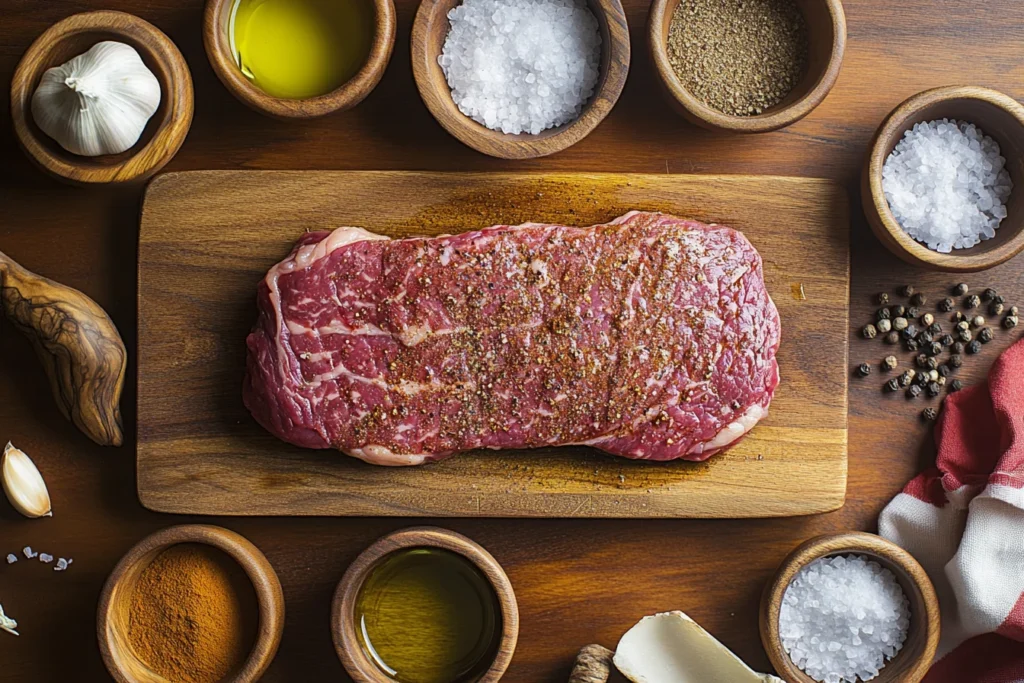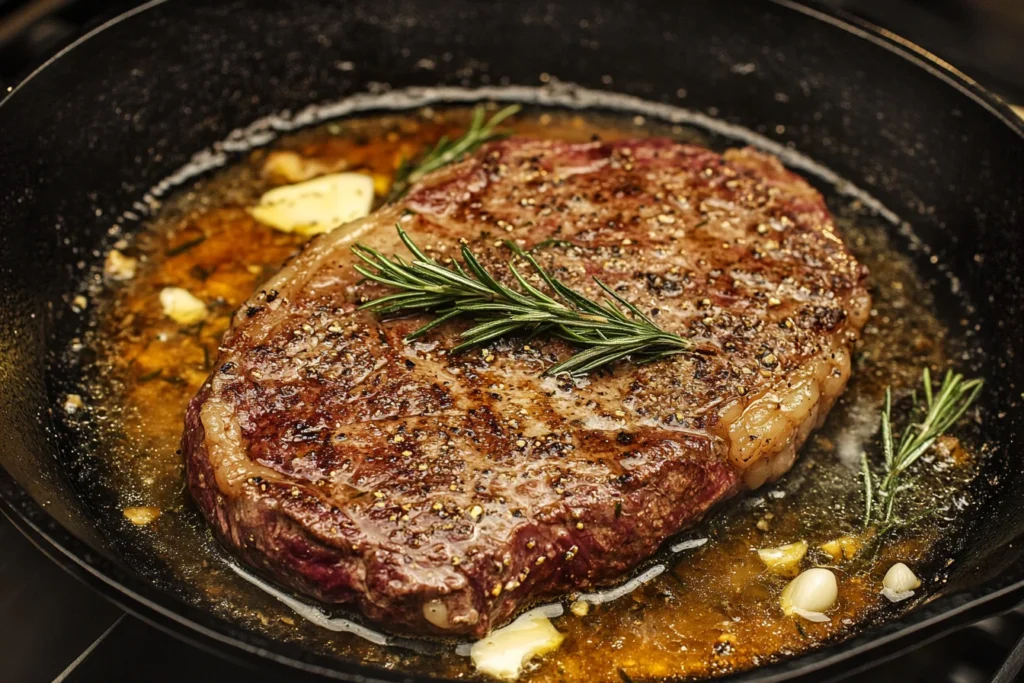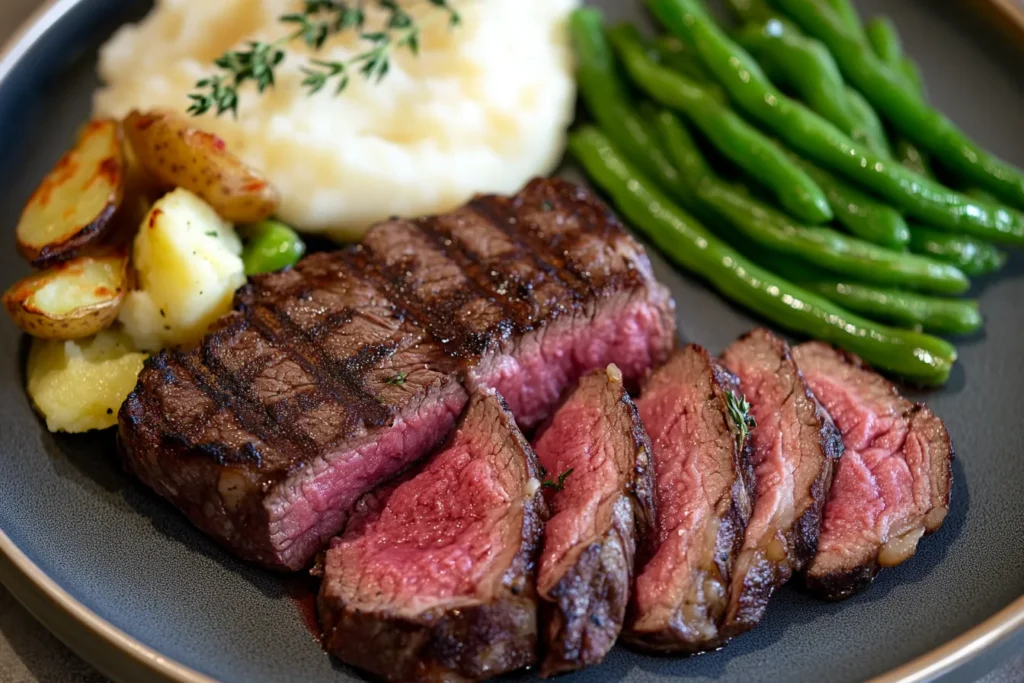Beef chuck eye steak, often dubbed the “poor man’s ribeye,” is a hidden gem among steak cuts. It boasts a flavor profile and tenderness that rivals premium cuts but comes at a fraction of the cost. This comprehensive guide will cover everything you need to know about selecting, preparing, and cooking this delectable cut of beef. Whether you’re a novice in the kitchen or a seasoned chef, this article will equip you with all the tips and tricks to perfect your chuck eye steak experience.
Introduction to Beef Chuck Eye Steak
Beef chuck eye steak is a versatile and affordable cut derived from the chuck primal section of a cow. Moreover, known for its marbling and rich flavor, this steak has earned a reputation as an excellent alternative to more expensive cuts like ribeye. Therefore, what exactly makes it unique, and why should you consider it for your next meal?
The answer lies in its balance of flavor, texture, and value. Unlike other chuck cuts, the chuck eye retains enough fat and marbling to deliver a tender, juicy bite when cooked correctly. In this section, we’ll delve deeper into what makes this steak so special.
Understanding the Cut
What Is Beef Chuck Eye Steak?
Beef chuck eye steak is cut from the fifth rib of the cow, situated right next to the ribeye. As a result, this proximity to a prime cut means it shares many of the ribeye’s prized qualities. However, it remains less expensive because the chuck section is generally less tender overall.
Despite its name, the chuck eye is not to be confused with standard chuck steak, which is tougher and best suited for slow cooking. The chuck eye is a rare find, as only two cuts can be extracted per cow.
Chuck Eye vs. Ribeye: Differences and Similarities
While the chuck eye is often compared to the ribeye, there are some notable differences:
- Marbling: Ribeye steaks have more extensive marbling, making them slightly more tender.
- Cost: Chuck eye steak is significantly more budget-friendly, making it ideal for steak enthusiasts on a budget.
- Flavor: Both cuts deliver robust, beefy flavors, though the ribeye’s fat content can intensify its taste.
Albeit less tender than ribeye, the chuck eye compensates with a depth of flavor that stands out when cooked properly.
Characteristics of Chuck Eye Steak
Flavor Profile
The beef chuck eye steak is renowned for its bold, beefy flavor, making it a favorite among meat enthusiasts. Its rich taste stems from the marbling that runs through the cut, which melts into the meat during cooking, imparting a savory, buttery essence. Additionally, its proximity to the ribeye ensures a taste profile that feels indulgent without breaking the bank.
Furthermore, when paired with the right seasonings or marinades, this steak can adapt to various cuisines, from classic American barbecue to flavorful Asian dishes.
Texture and Tenderness
Comparatively tender for a chuck cut, the chuck eye steak strikes a fine balance between firmness and softness. Its texture is sturdy enough to provide a satisfying bite yet soft enough to cut through with ease. However, its tenderness can vary slightly based on the cooking method. Techniques like pan-searing or grilling with care are key to ensuring a juicy and tender result.
Nutritional Information
The beef chuck eye steak is not just delicious but also packed with essential nutrients. Here’s a quick look at its nutritional profile per 3.5 ounces (100 grams):
- Calories: ~240 kcal
- Protein: ~23 grams
- Fats: ~18 grams (with a balance of saturated and unsaturated fats)
- Iron: Provides about 12% of the daily recommended intake.
- Zinc: Supplies nearly 30% of the daily value.
Besides being a great source of protein, chuck eye steak also contains vital micronutrients like vitamin B12, which supports energy metabolism and overall health. Despite its richness, consuming this steak in moderation is recommended due to its fat content.
Selecting the Perfect Chuck Eye Steak
What to Look for When Buying
When shopping for chuck eye steak, pay close attention to these features:
- Marbling: Look for steaks with a good amount of fat evenly distributed across the meat. This ensures flavor and tenderness.
- Color: The steak should have a bright, cherry-red hue, indicating freshness.
- Thickness: Opt for steaks that are at least 1 inch thick for better control during cooking.
- Packaging: If prepackaged, ensure the plastic wrap is tightly sealed with no air pockets or excess liquid in the tray.
Where to Purchase
Finding high-quality chuck eye steak may take a little effort. Local butchers often carry this cut, and their expertise ensures you’re getting a premium selection. Additionally, many grocery stores and online meat delivery services stock chuck eye steak, albeit in limited quantities since only two cuts come from each cow.
Preparing Chuck Eye Steak

Necessary Tools and Equipment
Before diving into the preparation process, having the right tools can make all the difference. Here’s what you’ll need:
- Cast iron skillet: Ideal for retaining heat and achieving a perfect sear.
- Meat thermometer: Ensures precise doneness levels.
- Sharp knife: For trimming excess fat or slicing the steak after cooking.
- Tongs: Helps handle the steak without piercing it, preserving its juices.
- Cutting board: Preferably wooden or plastic, sturdy enough for handling raw meat.
Additionally, ensure you have ample counter space for prepping and a clean, well-lit area for seasoning.
Seasoning and Marinating Tips
Seasoning plays a crucial role in enhancing the flavor of beef chuck eye steak. While the steak has a robust taste on its own, adding seasonings or marinades can elevate its profile.
Basic Seasoning Recipe:
- 1 tsp kosher salt
- ½ tsp freshly ground black pepper
- 1 tsp garlic powder
- 1 tsp smoked paprika
Steps for Seasoning:
- Pat the steak dry with a paper towel.
- Liberally coat both sides with the seasoning mixture.
- Let the steak rest for 15-30 minutes to absorb the flavors before cooking.
Marinating Tips:
If you prefer marinating, choose ingredients that complement the steak’s bold flavors. For example, a simple marinade could include olive oil, minced garlic, soy sauce, and a touch of lemon juice for added zing. Additionally, marinate the steak for 2-4 hours in the refrigerator for the best results.
Cooking Methods
Grilling Chuck Eye Steak
Grilling is one of the most popular ways to cook beef chuck eye steak because it imparts a smoky, charred flavor.
Steps to Grill:
To begin, preheat the grill to high heat, about 450°F. Next, place the seasoned steak on the grates and sear it for 2-3 minutes per side to develop a flavorful crust. Afterward, reduce the heat to medium and continue cooking for 4-6 minutes per side, depending on the desired doneness.
Ensure you rest the steak for 5 minutes before slicing to retain its juices.
Pan-Searing on the Stove
Pan-searing is perfect for achieving a restaurant-quality crust.
Steps to Pan-Sear:
First, heat a cast iron skillet over medium-high heat and add 1 tablespoon of olive oil. Next, place the steak in the skillet and sear it for 2-3 minutes per side. Then, lower the heat slightly, and add 1 tablespoon of butter. Meanwhile, baste the steak with the melted butter while cooking for another 2-3 minutes.

This method works well for medium-rare or medium doneness.
Broiling in the Oven
Broiling is an excellent choice when you can’t grill or sear.
Steps to Broil:
Preheat the oven’s broiler to high, ensuring the rack is positioned about 4 inches below the heat source. Next, place the seasoned steak on a broiler pan or an oven-safe wire rack. Then, broil the steak for 5-7 minutes per side, flipping once, until the desired doneness is achieved.
Keep a close eye on the steak to prevent overcooking.
Achieving the Desired Doneness
Using a Meat Thermometer
Achieving the perfect doneness for beef chuck eye steak requires precision, and therefore, a meat thermometer is your best friend. To ensure accuracy, insert the thermometer into the thickest part of the steak, avoiding the bone or fat pockets, for an accurate reading.
Here’s a quick temperature guide:
- Rare: 120°F – 125°F
- Medium-Rare: 130°F – 135°F
- Medium: 140°F – 145°F
- Medium-Well: 150°F – 155°F
- Well-Done: 160°F and above
Monitoring the temperature ensures the steak is cooked to your preferred level without overcooking.
Doneness Levels Explained
Understanding doneness levels can help you tailor the steak to your personal taste.
- Rare: Cool, red center with a soft texture. Ideal for those who enjoy a more raw taste.
- Medium-Rare: Warm, red center with slightly firmer edges. Perfect for enhancing the steak’s natural flavor.
- Medium: Pink center with a balance of firmness and juiciness. A versatile choice.
- Medium-Well: Slightly pink center with a firmer texture. Preferred by those who dislike excess moisture.
- Well-Done: Fully cooked with no pinkness. The steak is firm and dry, suitable for those who prefer a robust texture.
Resting the steak for 5 minutes after cooking is crucial, as it allows the juices to redistribute evenly.
Resting and Serving
Once the steak is cooked to perfection, resting it is non-negotiable. This is because during cooking, the juices migrate to the center of the meat. Therefore, resting for 5-10 minutes on a cutting board covered loosely with foil ensures the juices spread evenly throughout, making every bite succulent.
When it comes to serving, slice the steak against the grain to enhance tenderness. Additionally, pair it with your favorite side dishes to complement the robust flavor of the steak.
Pairing Suggestions
Side Dishes
Choosing the right sides can elevate your meal experience. Here are some excellent pairings:
- Mashed Potatoes: Creamy and buttery, they balance the steak’s rich flavor.
- Grilled Vegetables: Zucchini, bell peppers, and asparagus add a fresh, smoky touch.
- Caesar Salad: A crisp, tangy salad brings a refreshing contrast to the savory steak.
- Garlic Bread: Perfect for soaking up steak juices and adding a crunchy texture.
Beverage Pairings
For beverages, consider non-alcoholic options like sparkling water with a slice of lemon or a robust iced tea to cleanse the palate.

Storing and Reheating Leftovers
Proper Storage Tips
Leftover beef chuck eye steak can make a fantastic meal the next day, but proper storage is essential to preserve its flavor and texture.
- Cooling: Allow the steak to cool to room temperature, but don’t leave it out for more than two hours.
- Wrapping: Wrap the steak tightly in aluminum foil or place it in an airtight container to prevent moisture loss.
- Refrigeration: Store in the refrigerator for up to 3-4 days.
- Freezing: For long-term storage, wrap the steak in freezer paper and place it in a freezer-safe bag. It can stay fresh for up to 2-3 months.
Labeling the storage date ensures you consume it while it’s still at its best quality.
Reheating Methods
Reheating steak can be tricky, as overcooking may dry it out. Follow these methods for optimal results:
- Oven: Preheat the oven to 250°F. Place the steak on a wire rack over a baking sheet and heat for 20-30 minutes.
- Skillet: Use a medium-heat skillet with a small amount of butter or oil. Sear each side for 1-2 minutes to reheat while maintaining moisture.
- Microwave: Place the steak on a microwave-safe plate and cover it with a damp paper towel. Heat in 30-second intervals to avoid overcooking.
Frequently Asked Questions (FAQs)
Is Chuck Eye Steak the Same as Chuck Steak?
No, chuck eye steak is a specific cut from the chuck section of the cow, located near the ribeye. It’s more tender and flavorful than regular chuck steak, which is better suited for slow cooking.
How Does Chuck Eye Compare to Other Cuts?
Chuck eye steak is a budget-friendly alternative to ribeye, offering similar flavor and marbling at a lower price point. However, it’s slightly less tender than premium cuts like tenderloin or filet mignon.
Can I Use Chuck Eye Steak in Recipes Calling for Ribeye?
Yes, chuck eye steak is an excellent substitute for ribeye in most recipes. In fact, its comparable flavor and texture make it a versatile option for grilling, pan-searing, or broiling.
What Are Some Common Mistakes to Avoid When Cooking Chuck Eye Steak?
- Overcooking: Leads to a dry, tough texture.
- Skipping Resting Time: Causes juices to escape when slicing.
- Improper Seasoning: Fails to bring out the steak’s rich, beefy flavor.
Conclusion
Beef chuck eye steak is a flavorful, affordable cut that therefore deserves a place in your kitchen repertoire. In addition, by mastering the art of selecting, preparing, and cooking this steak, you can enjoy a restaurant-quality meal without breaking the bank. Ultimately, whether you grill it, pan-sear it, or broil it, the chuck eye steak is a testament to how simple techniques can transform an underrated cut into a gourmet delight.

